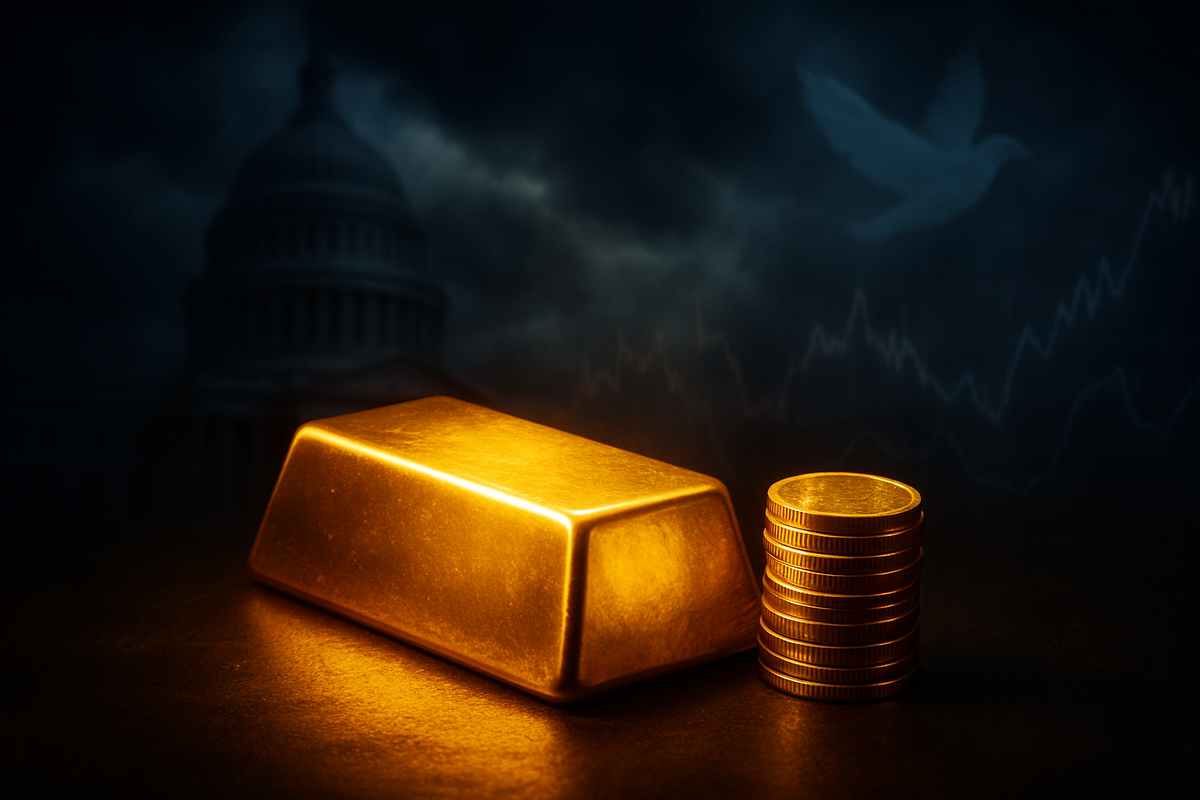
Gold futures have made history, surging past the unprecedented $4,000 per ounce mark for the first time ever on October 7, 2025. This monumental rise reflects a powerful confluence of investor anxiety, driven by a protracted US government shutdown, pervasive economic uncertainty, and a distinctly dovish stance from the Federal Reserve. The precious metal, long considered a bastion of stability in turbulent times, is now signaling a profound shift in market sentiment, with investors aggressively seeking safe havens amidst a landscape fraught with geopolitical tensions and domestic instability.
This historic ascent underscores a significant re-evaluation of risk by global investors. The relentless climb in gold prices—nearly 50% since the start of 2025—is a direct consequence of capital flowing out of riskier assets and into tangible stores of value. With the US government shutdown creating a vacuum of reliable economic data and the Federal Reserve signaling continued monetary easing, gold's appeal as a hedge against inflation and currency debasement has never been stronger, pushing its value into uncharted territory.
Gold's Historic Ascent: A Detailed Look at the Drivers and Timeline
On October 7, 2025, gold futures officially breached the $4,000 per ounce threshold, marking an unprecedented milestone in the commodity's history. This surge is not an isolated event but the culmination of several interlocking factors that have progressively eroded investor confidence in traditional growth assets and government stability.
The most immediate catalyst is the ongoing U.S. government shutdown, which, as of October 7, 2025, has entered its seventh day. This political gridlock has paralyzed government operations, delayed the release of critical economic indicators, and fueled widespread uncertainty about the nation's fiscal health and governance capabilities. The lack of clarity emanating from Washington has pushed investors towards assets perceived as independent of political whims. This current shutdown follows a series of similar impasses in recent history, each contributing to a cumulative sense of government instability and adding to the long-term appeal of safe-haven assets.
Compounding this domestic political turmoil is a broader landscape of economic uncertainty. Global trade tensions, particularly those stemming from President Donald Trump's ongoing tariff policies, have continued to weigh on international commerce and corporate profitability. Fears of persistent inflation and a potential slowdown in global economic growth have further incentivized a flight to quality. This environment, characterized by both geopolitical risks and macroeconomic headwinds, creates a fertile ground for gold's upward trajectory.
Adding significant fuel to gold's rally is the Federal Reserve's decidedly dovish monetary policy. The Fed has already initiated interest rate cuts earlier in 2025, and market expectations are high for further reductions in October and December. A dovish Fed lowers real interest rates, which in turn decreases the opportunity cost of holding non-yielding assets like gold. Moreover, lower interest rates tend to weaken the U.S. dollar, making gold more affordable and attractive to international buyers, thereby boosting global demand. Key players in this scenario include major investment banks like Goldman Sachs, which have adjusted their gold price forecasts upwards, and central banks, particularly those in emerging markets, which have been consistently accumulating gold to diversify their reserves away from the U.S. dollar. The initial market reaction has been a significant rebalancing of portfolios, with increased inflows into gold-backed exchange-traded funds (ETFs) and a noticeable shift in investor sentiment towards wealth preservation.
Corporate Fortunes: Winners and Losers in a $4,000 Gold Market
The unprecedented surge in gold prices to over $4,000 per ounce will undoubtedly create a distinct divide between corporate winners and losers across various sectors. Companies directly involved in gold production stand to gain significantly, while those sensitive to economic downturns or relying on strong consumer confidence may face headwinds.
Gold mining companies are the most obvious beneficiaries. With gold trading at record highs, their profit margins are set to expand dramatically. Major players like Barrick Gold Corp. (NYSE: GOLD) and Newmont Corporation (NYSE: NEM) will see increased revenue and profitability from their existing operations, potentially leading to higher stock valuations and increased capital for exploration and development. Junior mining companies with promising gold deposits may also find it easier to secure financing and attract investment. Furthermore, companies that provide services and equipment to the gold mining industry could also experience an uptick in business.
Conversely, companies heavily reliant on consumer discretionary spending or those sensitive to economic instability could struggle. High gold prices often reflect a broader environment of economic uncertainty, which typically leads to reduced consumer confidence and spending. Retailers, especially those in luxury goods (excluding gold jewelry, which might see a niche boost), travel, and hospitality sectors, could experience decreased demand. Similarly, sectors exposed to potential economic slowdowns, such as certain manufacturing industries or highly leveraged companies, might face increased pressure. Investment firms with significant exposure to growth stocks or those that have not diversified into safe-haven assets may also see their portfolios underperform.
The landscape for financial institutions is more nuanced. While some might benefit from increased trading activity in gold and related derivatives, others could face challenges if their lending portfolios are heavily exposed to sectors vulnerable to economic contractions. Gold-backed exchange-traded funds (ETFs) like SPDR Gold Shares (NYSE Arca: GLD) and iShares Gold Trust (NYSE Arca: IAU) are experiencing robust inflows, indicating strong investor demand for direct exposure to gold prices. This benefits the asset managers behind these funds. However, companies that are heavily invested in the U.S. dollar or other currencies that might weaken against gold in a safe-haven environment could see their international purchasing power diminish.
Wider Implications: Gold as a Bellwether for Global Sentiment
Gold's unprecedented surge above $4,000 per ounce is more than just a commodity price milestone; it serves as a potent bellwether for global economic sentiment and market anxieties. This historic performance signals a profound lack of confidence in the stability of traditional financial systems and governmental efficacy, particularly amplified by the ongoing US government shutdown.
Historically, gold has always been viewed as a safe-haven asset, a reliable store of value during times of crisis. Its current ascent fits perfectly into this historical pattern, mirroring previous surges during periods of geopolitical instability, such as the oil crises of the 1970s, the dot-com bubble burst, and the 2008 global financial crisis. What distinguishes this current rally is the convergence of a domestic political crisis (the US government shutdown) with broader global economic uncertainties and a highly accommodative monetary policy from the Federal Reserve. This trifecta of factors creates an almost perfect storm for gold's appeal.
The implications extend far beyond the precious metals market. Gold's strength suggests that investors are bracing for continued economic headwinds, potentially signaling a prolonged period of low growth, persistent inflation, or even stagflation. This could have ripple effects on other asset classes: a strong gold market often correlates with weakness in equity markets as investors rotate out of riskier assets. It could also put pressure on the US dollar, as a dovish Fed and political instability diminish the currency's attractiveness. Other commodities, particularly industrial metals, might face downward pressure if the economic uncertainty signaled by gold translates into reduced industrial demand.
Regulatory bodies and policymakers will be closely watching gold's performance. A sustained rally could prompt central banks globally to re-evaluate their monetary policies and reserve diversification strategies. The current US government shutdown, a key driver of this gold surge, highlights the urgent need for political stability and fiscal responsibility. Failure to address these underlying issues could lead to further erosion of confidence and continued flight to safe havens. The current situation draws parallels to periods of significant sovereign debt concerns, where gold's role as an ultimate hedge against currency debasement becomes paramount.
What Comes Next: Navigating the Golden Horizon
The unprecedented rise of gold above $4,000 per ounce opens up a range of possibilities and challenges for investors and companies alike, both in the short and long term. The immediate future for gold prices will largely hinge on the resolution of the US government shutdown and the Federal Reserve's subsequent monetary policy decisions.
In the short term, a swift and decisive resolution to the government shutdown could alleviate some of the immediate safe-haven demand, potentially leading to a temporary pullback in gold prices. However, if the shutdown drags on or if the underlying economic uncertainties persist, gold is likely to maintain its upward momentum, possibly targeting new highs as predicted by some analysts. The Federal Reserve's communication will be critical; any hint of a shift away from its dovish stance could introduce volatility, but a continued commitment to lower rates will likely sustain gold's appeal.
Looking further ahead, the long-term outlook for gold remains robust as long as global economic growth remains tepid, inflation concerns linger, and geopolitical tensions persist. Investors may need to strategically pivot their portfolios, increasing their allocation to precious metals and other inflation-hedging assets. Companies, particularly those in the mining sector, will need to adapt to sustained high gold prices, potentially accelerating exploration, expanding production, and optimizing operational efficiencies to capitalize on wider margins. This could also lead to increased M&A activity within the gold industry.
Emerging market opportunities could arise as central banks continue to diversify their reserves, potentially increasing their gold holdings. Challenges, however, include the potential for increased regulatory scrutiny on the gold market and the risk of "uptrend exhaustion" if the rally becomes unsustainable. Potential scenarios include a continued, albeit volatile, ascent for gold if economic uncertainty deepens, or a more stabilized market if global conditions improve and confidence returns to traditional assets. Investors should closely monitor inflation data, central bank communications, and geopolitical developments for cues on gold's future trajectory.
The Golden Standard: A Wrap-Up of a Historic Market Shift
The ascent of gold futures above $4,000 per ounce marks a truly historic moment in financial markets, signaling a profound shift in investor psychology and a palpable lack of confidence in the current economic and political landscape. The key takeaways from this event are clear: safe-haven demand, fueled by the ongoing US government shutdown and broader economic uncertainty, coupled with a dovish Federal Reserve, has propelled gold to unprecedented heights. This isn't merely a commodity price spike; it's a powerful indicator of deep-seated anxieties within the global financial system.
Moving forward, the gold market is likely to remain a focal point for investors. Its performance will continue to serve as a critical barometer of economic sentiment, reflecting the ebb and flow of confidence in government stability, monetary policy, and global growth prospects. While the immediate drivers such as the US government shutdown may eventually resolve, the underlying concerns about inflation, geopolitical risks, and the long-term health of the global economy are likely to persist, maintaining a strong fundamental basis for gold's appeal.
Investors should closely watch for any developments regarding the US government shutdown, as its resolution or prolongation will significantly impact short-term market dynamics. Furthermore, the Federal Reserve's future interest rate decisions and any shifts in its dovish stance will be crucial. Global inflation data and major geopolitical events will also play a pivotal role in shaping gold's trajectory. This historic surge underscores the enduring value of diversification and the importance of understanding gold's role as a hedge against systemic risks.
This content is intended for informational purposes only and is not financial advice


















